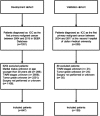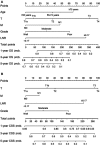Nomograms for predicting overall survival and cancer-specific survival in patients with surgically resected intrahepatic cholangiocarcinoma
- PMID: 31440084
- PMCID: PMC6664419
- DOI: 10.2147/CMAR.S212149
Nomograms for predicting overall survival and cancer-specific survival in patients with surgically resected intrahepatic cholangiocarcinoma
Abstract
Purpose: To develop and validate nomograms for predicting overall survival (OS) and cancer-specific survival (CSS) in patients with surgically resected intrahepatic cholangiocarcinoma (ICC).
Patients and methods: The nomograms were developed using a development cohort of 947 ICC patients after surgery selected from Surveillance, Epidemiology, and End Results database, and externally validated using a training cohort of 159 patients admitted at our institution. Nomograms for OS and CSS were established based on the independent prognostic factors identified by COX regression models and Fine and Grey's models, respectively. The performance of the nomograms was validated internally and externally by using the concordance index (c-index), and calibration plot, and compared with that of AJCC 8th edition TNM staging system by using c-index and decision curve analysis.
Results: Age, T stage, M stage, lymph node ratio (LNR) level and tumor grade were independent prognostic predictors for OS in ICC patients, while T stage, M stage, LNR level and tumor grade were independent prognostic predictors for CSS. Nomogram predicting OS was with a c-index of 0.751 on internal validation and 0.725 up to external validation, while nomogram for CSS was with a c-index of 0.736 on internal validation and 0.718 up to external validation. Calibration plots exhibited that the nomograms-predicted and actual OS/CSS probabilities were fitted well on both internal and external validation. Additionally, the nomograms exhibited superiority over AJCC 8th edition TNM staging system with higher c-indices and net benefit gains, in predicting OS and CSS in ICC patients after surgery.
Conclusion: The constructed nomograms could predict OS and CSS with good performance, which could be served as an effective tool for prognostic evaluation and individual treatment strategies optimization in ICC patients after surgery in clinical practice.
Keywords: cancer-specific survival; intrahepatic cholangiocarcinoma; nomogram; overall survival.
Conflict of interest statement
The authors report no conflicts of interest in this work.
Figures








References
LinkOut - more resources
Full Text Sources

